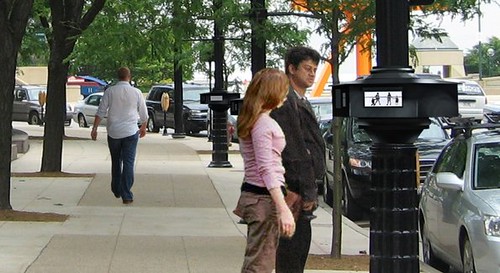What’s up in Milwaukee?
On April 1, Mary Louise Schmacher wrote an article in the Milwaukee Wisconsin Journal Sentinel titled “Why Milwaukee is ready for Zweig’s public art.” She begins the article:
“Here’s hoping Milwaukee has finally found a public art project that it can embrace. Janet Zweig’s proposal for E. Wisconsin Ave., which goes before the Common Council’s Public Works Committee this morning at 9 a.m. is a quiet, poetic work that will delight and surprise pedestrians.
“Zweig defines the term ‘public’ in ‘public art’ in entirely new and truly meaningful ways. Instead of creating committees that get nominal community “input”, that have token artists offer opinions before commissioning static works of forgettable art, as has been done repeatedly here, Zweig’s art engages Milwaukee in a thoughtful and genuine way.”
Read the full article.
Later that same day, Schumacher blogged: “Janet Zweig’s public art project in trouble.” In detailing what happened at the meeting of the Public Works Committee of the Common Council, Schumacher quoted some of the responses at the meeting.
“Ald. Robert G. Donovan left the room, saying, ‘I refuse to have my name attached to something as ridiculous as that.’
“Aldermen Joe Dudzik and Willie C. Wade also objected to the ‘old school’ technology, signs similar to those used in train stations until a few decades ago, which would be used to make animations.”

Prototype of Zweig’s proposed project.
Dudzik and Wade said, according to Schumacher in a related article:
“‘We are taking about a design that holds us back or indicates that we are stuck in the past,’ said vice chairman Ald. Joe Dudzik, referring to the old-fashioned signs that Zweig uses to create short animations.
“‘I am just not feeling it,’ said Ald. Willie Wade. ‘But then I wouldn’t pay 50 cents for the Mona Lisa.'”
I’m not familiar with the situation on the ground, and it’s hard to imagine why a 3-year, $300,000 project appears to have caught the Council by suprise with only one speaker in support of the proposal. Nevertheless, I’m a fan of both Zweig’s work and the “old-fashioned” technology she proposes to use – wonderfully, I think.

When I first saw Zweig’s Impersonator – not in person, unfortunately – I was captivated. The flip technology is best known for its use in transportation hubs, such as train stations and airports, and it is this association that makes it like a sign post for the imagination. What if I was going to Lille today? Where exactly is Strasbourg? How long would it take to get out of town to Chicago?
Janet Zweig, Professor Obsessive and His Two Compulsions from Steve Dietz on Vimeo.
In Milwaukee, Zweig is proposing a series of animations using the flip signs, as in the example above. I think it’s interesting that the council members apparently complained about the low tech nature of this proposal. For me, it is evocative of the invention of cinema with devices such as the zoetrope and conjures an entire cinema paradiso of imaginative pleasure. When ZER01 presented Peter Hudson’s Homouroboros zoetrope at the 2nd 01SJ Biennial, no one complained about how low tech it was. It was a magical experience.
The geneaology of Zweig’s Milwaukee proposal is from Impersonator (2002), through Carrying On (2004), a 1200 foot frieze at the Prince Street station of the New York subway, which celebrates the significance and individuality of the citizens of New York. In Milwaukee, she proposes to marry the graphic style of Carrying On, with the technology of Impersonator in a kind of homespun, so to speak, cel animation, similar to this unrealized proposal for an airport baggage claim area. Of course, I’d much rather be reading sponsored advertising on a “high tech” screen while I’m waiting for my luggage to not appear after a long flight home from Lille or Strausbourg. . . .
By the way, Zweig’s Impersonator made the top 5 “high tech” public artworks on CNET along with some other amazing projects.
And the internationally renowned artist duo, Thomson + Craighead use the same vendor – one of the few, if not the only remaining manufacturer of this technology anywhere in the world – to create a highly-praised work, Beacon, which has been shown at London’s prestigious British Film Institute and FACT: the Foundation for Art and Creative Technology.
But apparently it’s too low tech for Milwaukee. Or not?



